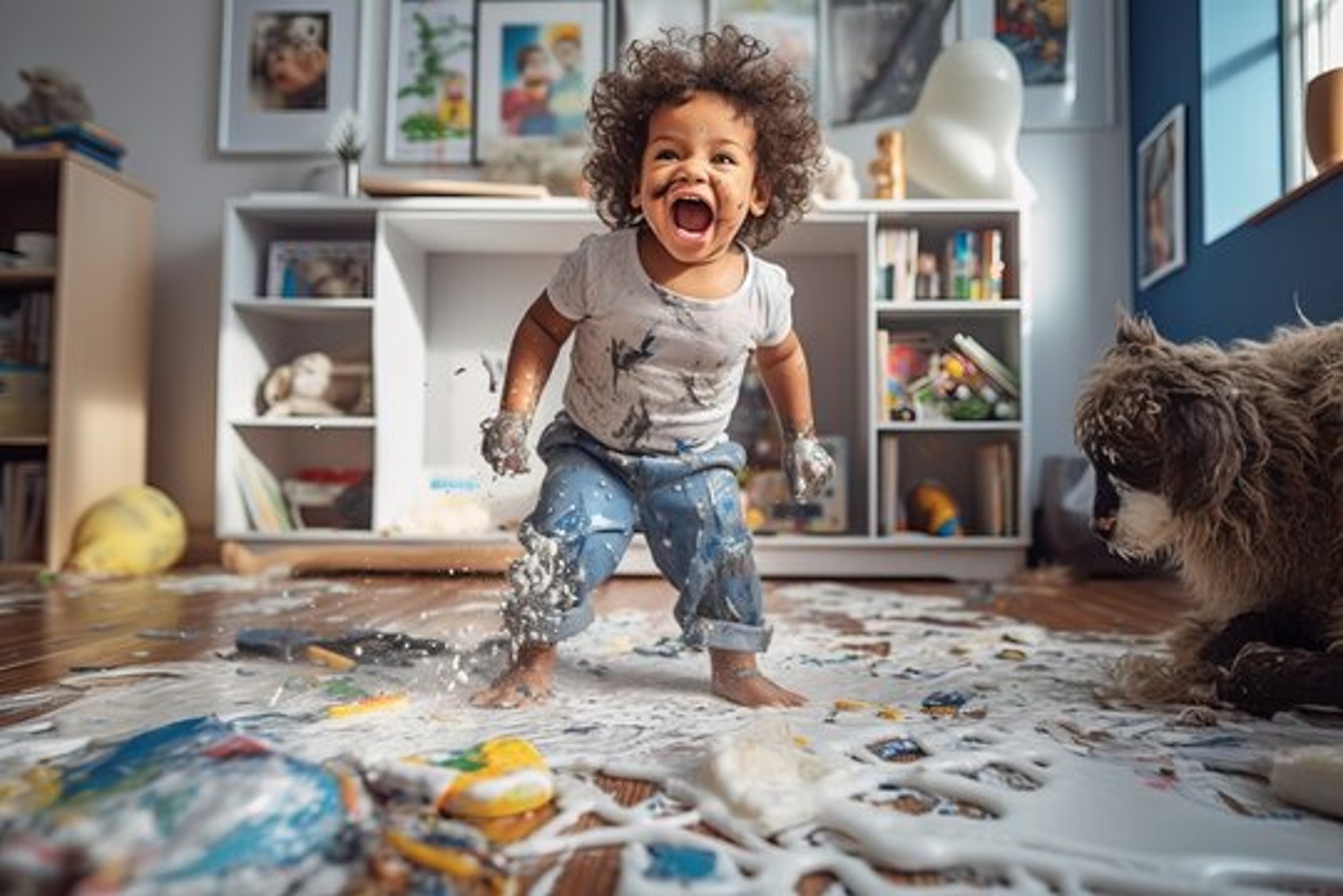子どもの「いたずら」は、親にとって頭を悩ませる行動のひとつかもしれません。ドキッとするようなことをしてみたり、予想外の場所をいじってみたり…。「どうしてこんなことをするの?」と戸惑うこともあるでしょう。
しかし、実はこうしたいたずらこそが、子どもの探求心や好奇心の現れであることをご存じでしょうか?大人からすれば「困った行動」と見えるものも、子どもにとっては「新しいことを学ぼうとする行動」のひとつであり、その体験を通して多くのことを学び取っているのです。
今回は、「いたずら」の捉え方や、その対応方法について、ポジティブな視点で考えてみたいと思います。
1. いたずらは子どもの探求心と好奇心から生まれる
- 未知の世界への挑戦
子どもは常に新しい世界を発見したい、生き物としての本能的な欲求を持っています。触ってはいけないと言われたものや、普段見慣れないものほど興味をそそられるのは当然といえるでしょう。大人から見ると「いたずらしている」ように見えても、子ども自身は「どうなっているのか知りたい」「こうしたらどうなるんだろう?」と真剣な探求心を働かせているのです。 - 五感をフルに使う学び
子どもにとっての学びは、五感を総動員して行われます。やたらと物を舐めてみたり、ボタンを押してみたり、手でぐちゃぐちゃにしてみたり…これらはすべて、手触りや味、動きなどを体感しながら世界を理解しようとする行為です。大人が思う「ただのいたずら」も、子どもにとっては大切な実験の場なのかもしれません。
2. 見守る基準:物を壊すか、人を傷付けるか
- 安全が最優先
もちろん、いたずらがエスカレートして物が壊れてしまう、他人にケガをさせてしまうなどは防ぎたいところです。しかし、その一歩手前である「ちょっとびっくりするような行動」や「少し面倒な片付けが必要になる程度」のいたずらなら、大目に見てもいいかもしれません。 - ルールを明確に伝える
例えば、危険な道具や壊れやすいものについては「ここまではOK、ここからはダメ」という境界を分かりやすく設定しましょう。ただし、その際にも「どうして危ないのか」「壊れるとどう困るのか」を子どもにも理解できる言葉で説明することが大切です。子どもは理由を聞くと納得しやすくなり、無闇にそれを触ろうとはしなくなるでしょう。
3. いたずらを通じて得られる成長
- 発想力と問題解決能力の向上
「こうしたらどうなる?」という試行錯誤は、子どもの創造性や発想力を高めます。失敗したり、思わぬ結果が生じたりすることから、結果を予測する力や問題解決能力を学んでいくのです。 - 自分で考え、行動する主体性
いたずらの大半は、子どもが「やってみたい!」と思い、主体的に起こす行動です。誰かに言われてではなく、自分の意思で動いているからこそ、学びや気づきも深くなります。のびのびと試す経験は、やがて将来の主体性や自信につながることでしょう。 - 成功と失敗を肌で感じる
いたずらの中には、ときに「上手くいかない」結果を招くことがあります。しかし、それこそが子どもの学習の大きなチャンスです。「やりすぎたらこうなるのか」と失敗から学ぶことで、次回はより安全な方法を試したり、周囲に配慮した行動を考えるようになります。
4. 親としての関わり方
- あえて“少し困る”くらいは許容する
いたずらが始まると、つい「やめなさい!」とストップをかけたくなるのは当然です。しかし、子どもにとってその体験は一度しかないかもしれません。後片付けがちょっと面倒でも、「これはどんな学びにつながるだろう?」と考え、見守ってみるのも一つの手です。 - 適切なフィードバックを与える
子どものいたずらが終わったあと、「どうだった?」「こうすると危なかったね」「これは面白かったね」というふうにフィードバックを与えましょう。ただ叱るだけではなく、子どもの試みを評価し、良い点と反省点を一緒に整理してあげると、次につながる学びが深まります。 - 親自身のストレスケアも大切
とはいえ、いたずらの片付けは時に大変。親だって人間ですから、イライラしてしまうこともあるでしょう。そんなときには、気分転換を工夫したり、周囲に協力を仰いだりすることが大切です。親が余裕を持てないと、子どもの貴重な学びを奪ってしまうかもしれません。
まとめ
子どものいたずらは、言い換えれば「探求心と好奇心が爆発している証拠」。物を壊したり、人を傷付けるような危険な行為でなければ、ある程度は見守ってあげることも大切です。そこには子どもが主体的に動き、学び、成長するための大きな可能性が隠れています。
- いたずら=ダメなこと と決めつけるのではなく、まずは子どもの視点に立って「どうしてこれをしたのか」「何に興味を持っているのか」を考えてみましょう。
- 安全とルールを守る範囲内であれば、多少のリスクや面倒を許容することで、子どもの学びがぐんと深まるかもしれません。
- 親がイライラして叱りすぎてしまうと、子どもの自由な発想や主体性を抑え込んでしまう可能性があるので注意しましょう。
結局のところ、子育てとは「子どもの興味関心と安全をどう両立させるか」の連続とも言えます。いたずらを“ただの悪い行為”と見るか、“大きな可能性を秘めたチャレンジ”と見るかで、親の行動や子どもの成長にも大きな差が生まれるでしょう。ぜひ、子どもの好奇心と探求心を尊重しながら、一緒に楽しく学べる環境をつくってみてください。
No Breaks, No Hurts—All Good! How to Nurture a Child’s Mischief
For many parents, a child’s “mischief” can be a source of endless worry and surprise. They may do things that startle us or mess with objects we never thought they’d touch. We might find ourselves asking, “Why in the world do they do that?”
However, did you know that much of this “mischief” is actually your child’s curiosity and spirit of exploration at work? While adults may see such behavior as “troublemaking,” for children, it’s often just another way of learning about the world around them. In this article, we’ll take a positive view of these mischievous acts and explore how to handle them.
1. Mischief Arises from a Child’s Curiosity and Spirit of Exploration
- Venturing into the Unknown
Children have a natural desire to discover new worlds. The more unusual or forbidden something seems, the more it captivates their attention. From an adult’s perspective, their actions look like pure mischief, but the child may be thinking, “I want to understand how this works!” - Learning Through the Senses
Children learn by using all five senses. Tasting random objects, pressing buttons, squishing things with their hands—these seemingly aimless actions help them understand textures, tastes, and movements. What looks like “just mischief” to us can be an important experimental process for them.
2. Where to Draw the Line: Breaking Objects or Hurting Others
- Safety First
Naturally, we want to prevent damage to objects or harm to others. But for smaller acts—those that might make us go, “Oh no, not again,” or require a bit of cleanup—it could be beneficial to let them explore. - Clearly Communicate Rules
For potentially dangerous items or fragile objects, set clear boundaries like “This part is okay, but this area is off-limits.” Also, explain why it’s dangerous or how it could cause problems if broken. Children are often more willing to comply when they understand the reasons.
3. Growth Through Mischief
- Boosting Creativity and Problem-Solving
As children think, “What happens if I do this?” they’re developing creativity and the ability to predict outcomes. Even when things go wrong, they learn from the unexpected results, sharpening their problem-solving skills. - Fostering Independence
Most mischief stems from the child’s own will—“I want to try this!” Because they decide for themselves, the learning that takes place is profound. This experience can boost their confidence and sense of independence in the long run. - Feeling Success and Failure
Mischief sometimes leads to mishaps. But that can be a huge learning opportunity. By experiencing minor failures—like realizing they went too far—they learn to adapt and act more safely next time.
4. How Parents Can Support
- Allow a Little “Trouble”
It’s natural to want to stop your child immediately when they start getting into things. However, these are once-in-a-lifetime experiences for them. Even if some cleanup is needed later, ask yourself, “What might they learn from this?” and consider allowing it to some extent. - Provide Appropriate Feedback
Once the mischief is done, talk with your child: “How did that work out?” “That was a bit dangerous, wasn’t it?” or “That was interesting, right?” Don’t just scold—appreciate their attempt while also discussing possible improvements or caution for next time. - Don’t Forget Your Own Stress Management
Cleaning up can be exhausting, and it’s easy to get irritated. Parents are only human. Seek ways to relieve stress or ask others for help. A parent’s stress can inadvertently stifle a child’s valuable learning opportunities.
Conclusion
Mischief is essentially “evidence of a child’s exploding curiosity.” As long as it doesn’t involve breaking things or hurting people, there’s value in stepping back and letting them explore. After all, it’s in these spontaneous actions that children learn, grow, and discover their world.
- Don’t label all mischief as “bad.” Think about why your child did it and what sparked their interest.
- If it’s within the bounds of safety and house rules, allowing a bit of mess or risk can significantly deepen their learning.
- Over-scolding can suppress a child’s creativity and independence, so watch out for that.
In the end, parenting is about balancing a child’s curiosity with their safety—a constant juggling act. Whether you see mischief as “just bad behavior” or a “door to new possibilities” can change not only how you respond but also how much your child learns and grows. Embracing their curiosity and guiding them can make for a more enriching environment for everyone.




コメント